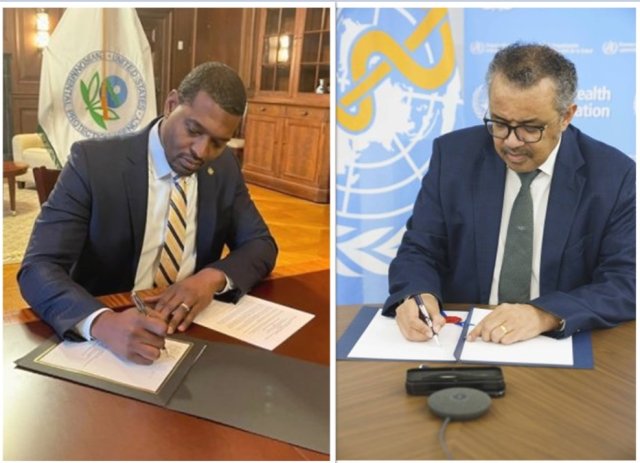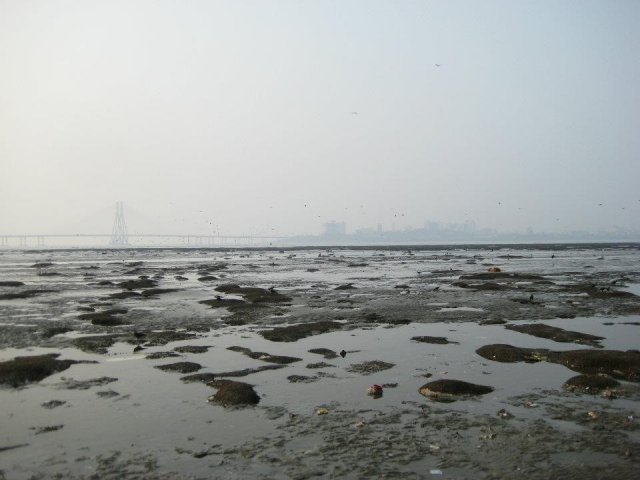EPA's Collaboration with the World Health Organization (WHO)

Environmental factors have a major effect on human health. In fact, a WHO Study found that modifiable environmental factors, such as air pollution, man-made climate and ecosystem change, and radiation are globally responsible for 24% of deaths and 28% of deaths among children under five.
EPA has a longstanding program of cooperation with the World Health Organization (WHO) to address the direct link between protecting public health and supporting a clean environment. EPA’s mission, to protect human health and the environment in the United States, naturally aligns with WHO’s goal to build a better, healthier future for all people.
Visit the official website of the World Health Organization.
Highlights
EPA Renews Agreement to Partner with WHO

January 2022: EPA Administrator Regan and WHO Director General Dr. Tedros held a virtual ceremony and signed a Memorandum of Understanding renewing cooperation between WHO and EPA. The agreement addresses key areas of collaboration on environmental health. The first EPA-WHO MOU was signed at the 1992 Rio de Janeiro Earth Summit.
First WHO Global Conference on Air Pollution and Health
EPA participated in the First WHO Global Conference on Air Pollution and Health, held October 30-November 1, 2018 in Geneva, Switzerland. The event, called for by the 16th World Health Assembly in 2016, sought to further elevate awareness and action among a wide range of stakeholders with a view to reducing the WHO-estimated 7 million premature deaths globally from ambient and household air pollution. Particular attention was aimed at connecting the health and environmental sectors. The event garnered major international interest resulting in attendance of almost 900 participants that identified numerous concrete actions they would take to address air quality. The WHO will host the second Global Conference on Air Pollution and Health in Accra, Ghana in October 2024.
About WHO
As the coordinator of international health for the United Nations, WHO produces public health guidelines and standards, supports health research, and helps countries address public health issues. WHO’s goal is to ensure that a billion more people have universal health coverage, to protect a billion more people from health emergencies, and provide a further billion people with better health and well-being.
WHO’s 194 member states appoint delegates to attend the World Health Assembly, the legislative and supreme body of WHO. The agenda for World Health Assembly meetings is set by an executive board, which has 34 members elected for three year terms. WHO also has six regional offices for Africa, the Americas, South-East Asia, Europe, the Eastern Mediterranean, and the Western Pacific.
EPA @ WHO
EPA and WHO cooperate on a wide range of environmental and public health issues, such as air quality, priority toxics, and water and sanitation. We also work with WHO on shared efforts to assess risk, to understand how environmental factors contribute to disease, and to develop WHO guidelines for environmental standards (e.g. for air and drinking water quality).
EPA’s activities with WHO are advanced under a memorandum of understanding. Specific areas of work include:
Climate Change and Human Health
Climate change negatively impacts human health, through increased heat-related mortality and sickness, worsened air quality, and more rapid spread of vector-, water- and food-borne diseases, particularly among vulnerable populations. EPA is collaborating with the WHO and others to promote the importance of taking health risks associated with the changing climate into account in the development of policy responses and programs.
Indoor and Outdoor Air Quality and Health

EPA works with WHO to support reductions in air pollution generated in low- and middle-income countries, which has the potential to travel across country boundaries.
EPA continues to raise awareness about the need for enhanced cooperation between environmental and public health communities to address this complex challenge. In 2018, the UN General Assembly’s (UNGA) 3rd High Level Meeting on Prevention and Control of Non-Communicable Diseases (NCDs) identified air pollution as a major risk factor contributing to the over 70% of global deaths due to NCDs. This includes deaths from cardiovascular diseases, chronic respiratory diseases, and lung cancer. The Declaration called for “Increased global awareness, action and international cooperation on environmental risk factors, to address the high number of premature deaths from (NCDs) attributed to human exposure to indoor and outdoor air pollution.”
EPA also played a leadership role in the adoption of a Health and Environment resolution at the third UN Environment Assembly, to affirm the importance of joint efforts to address health and environment, and requesting the UN Environment Programme work with WHO and other relevant organizations on the environment and health nexus.
EPA provides ongoing technical expertise to help revise WHO’s guidelines for monitoring outdoor air pollution and disseminate information on effective interventions to improve outdoor air quality. As part of this collaboration, EPA provided technical input to WHO's 2021 updated global air quality guidelines, which are used by countries around the world to implement their air quality programs.
EPA also works with WHO to reduce cookstove/household energy emissions in order to reduce the health, climate, environment, gender, and livelihood impacts of burning solid fuels (biomass and coal). EPA supports the implementation of WHO Guidelines for indoor air quality, including by disseminating evidence, recommendations, and options towards the achievement of clean cooking solutions. This work contributes to sustainable development and reduces poverty in low- and middle-income countries.
The International Organization for Standardization (ISO) has recently released laboratory testing protocols for cookstove and clean cooking technologies, and a set of voluntary performance targets (VPTs) for emissions, efficiency, and safety. EPA and WHO are working together to host a series of in-person and virtual workshops support the adoption or adaptation and implementation of the ISO standards and VPTs. At the workshops, representatives from LMICs develop short-and-medium term action plans to address indoor air pollution, primarily focusing on promoting cleaner methods of cooking, heating and lighting. These regional standards dissemination workshops have been held in Asia, East Africa, and West Africa (for Francophone countries and Haiti), and are currently underway in Latin America.
EPA also provided expert review of WHO’s International Radon Project, which recommended measures building professionals can use to reduce health risks from radon exposure. This project included the development of training material which has informed national radon reduction programs around the world. EPA and WHO have collaborated to promote the adoption of member state national radon action plans, and disseminate key health messages from the WHO Radon Handbook. WHO continues to maintain an online platform to support technical and communications experts to share effective radon interventions, and develop a database of radon regulations.
Children’s Environmental Heath
EPA and WHO contributed to the development of a global initiative on Children’s Environmental Health Indicators, to increase international cooperation, improve assessment of children’s environment health, and monitor the success or failure of interventions. The resulting training package for health care providers on children’s environmental health is now available on the WHO website.
Chemicals and Toxics
EPA currently serves as the Advisory Group Chair of the Global Alliance to Eliminate Lead Paint (Lead Paint Alliance), led by a joint secretariat of WHO and the United Nations Environment Programme. The Lead Paint Alliance is working to promote lead paint laws worldwide to eliminate lead in paint, including household paint and paint used on children’s toys. WHO leads the annual International Lead Poisoning Prevention Week each October in partnership with EPA.
EPA helped create WHO’s Chemical Risk Assessment Network, launched in 2012. This network has improved global chemical risk assessment though scientific exchanges, capacity building, and identification of research needs and emerging health risks. EPA and WHO continue to collaborate on best practices to evaluate chemicals and pollutants and to train global experts in these methods.
Water, Sanitation and Health

EPA has long supported WHO’s guidelines on drinking water quality and guidelines for recreational water quality. At present, EPA and WHO are evaluating chemical and microbial components in drinking water and recreational waters, two critical considerations for ensuring safe water for human consumption and recreation.
EPA and WHO developed guidelines for Sanitation Safety Planning to support the safe reuse of wastewater and greywater in agriculture, improve waste management and better protect water quality. These guidelines will support water suppliers, governments and other stakeholders. The EPA and WHO continue to collaborate on the development of guidelines and other reports such as the Second Edition of the Toxic Cyanobacteria in Water guide, Application of Quantitative Microbial Risk Assessment for Water Safety Management report, the Water Safety in Distribution Systems report and the Protecting Surface Water for Health report, among others.
Environmental Burden of Disease
EPA supported WHO efforts to quantify disease caused by environmental factors. In 2006, WHO produced the first global estimates of the loss of quality years of life as a result of exposures to lead, indoor smoke from solid fuels, outdoor air pollution, water, sanitation and hygiene, and climate change. These estimates were updated in a WHO report on preventing noncommunicable diseases. EPA and WHO continue to work to compile data and analyze how environmental factors contribute to diseases levels at the country level.
- View: Global estimates of burden of disease caused by the environment and occupational risks (WHO)
- View: Preventing Noncommunicable Diseases (NCDs) by Reducing Environmental Risk Factors (WHO)
Useful Links
The following links exit the site
- World Health Organization (WHO)
- Preventing Disease through Health Environments: A Global Assessment of the Burden of Environmental Risks
- WHO Information on Air Pollution
- WHO Children's Health and the Environment
- WHO Guidelines for Drinking-Water Quality
- WHO Information on the Global Alliance to Eliminate Lead Paint
- WHO International Programme on Chemical Safety
- WHO Information on Sanitation Safety Planning
- WHO Information on Radon
Explore all of EPA's work with International Organizations
